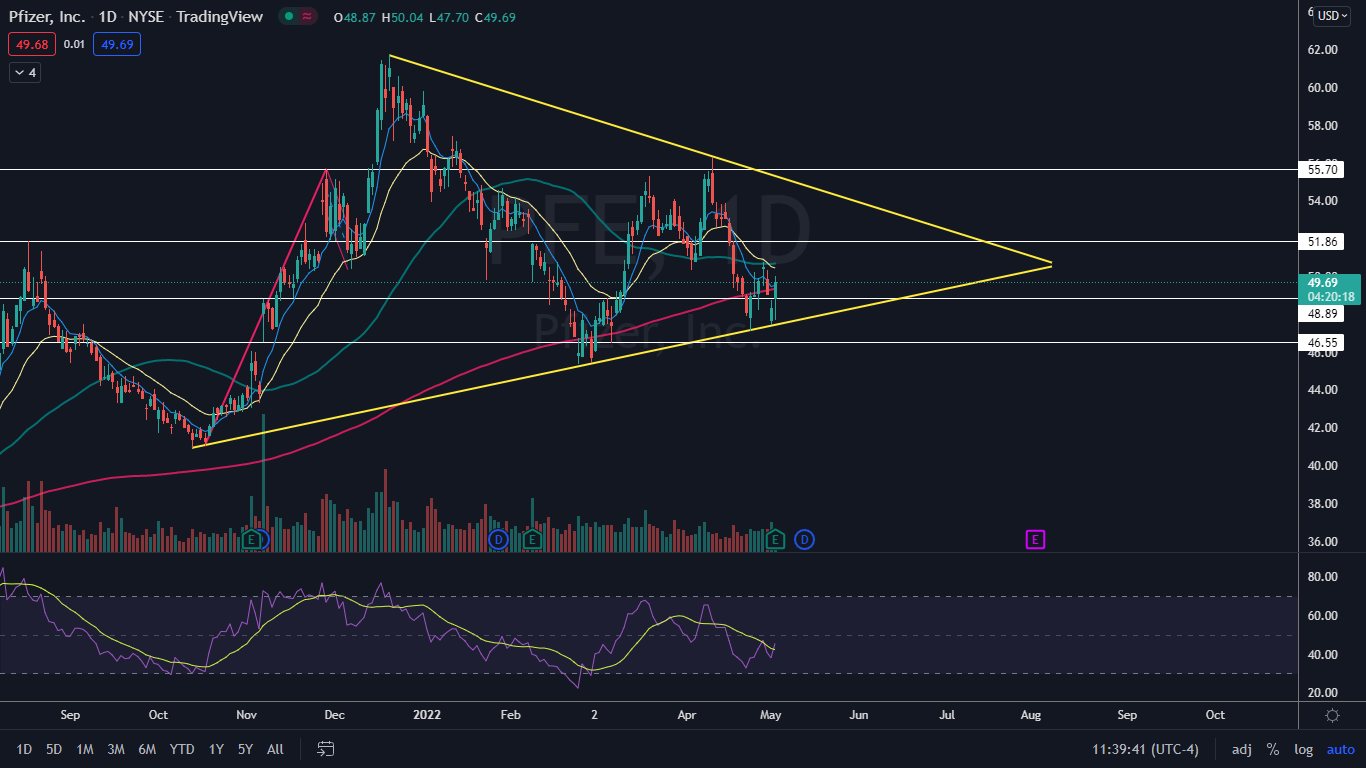Pfizer, Inc shot up over 3 percent on Tuesday after printing its first-quarter earnings before the market open.
The pharmaceutical giant reported adjusted earnings per share of $1.62, which beat the consensus estimate of $1.50. Pfizer reported sales of $25.70 billion, beating the $23.95 billion estimate. $13.2 billion of Pfizer’s sales came from its COVID-19 vaccine.
For the full-year 2022, Pfizer lowered its EPS guidance slightly from $6.35-$6.55 to $6.25-$6.45 and reaffirmed it expects sales of $98 billion-$102 billion, which comes in below the $107.94 billion estimate.
The reaction to Pfizer’s earnings print was initially bearish, with the stock trading down slightly in the premarket but once the market opened, bulls came in and bought the dip, which confirmed the stock is now trading in an uptrend.
An uptrend occurs when a stock consistently makes a series of higher highs and higher lows on the chart. The higher highs indicate the bulls are in control while the intermittent higher lows indicate consolidation periods.
Traders can use moving averages to help identify an uptrend with rising lower timeframe moving averages (such as the eight-day or 21-day exponential moving averages) indicating the stock is in a steep shorter-term uptrend and rising longer-term moving averages (such as the 200-day simple moving average) indicating a long-term uptrend.
A stock often signals when the higher high is in by printing a reversal candlestick such as a doji, bearish engulfing or hanging man candlestick. Likewise, the higher low could be signaled when a doji, morning star or hammer candlestick is printed. Moreover, the higher highs and higher lows often take place at resistance and support levels.
In an uptrend the “trend is your friend” until it’s not and in an uptrend there are ways for both bullish and bearish traders to participate in the stock:
Bullish traders who are already holding a position in a stock can feel confident the uptrend will continue unless the stock makes a lower low. Traders looking to take a position in a stock trading in an uptrend can usually find the safest entry on the higher low.
The Pfizer Chart
On Tuesday, Pfizer confirmed its new uptrend by rising up above Monday’s low-of-day at the $47.46 mark, which makes that level the most recent higher low. Pfizer will need to print a higher high above the April 28 high of $50.77 over the coming trading days for the uptrend to remain intact.The rise higher on Tuesday has allowed Pfizer to regain support at the 200-day simple moving average (SMA). The 200-day SMA is a bellwether indicator for technical traders because it acts as the boundary between what’s considered a bull versus a bear cycle for a security.
Pfizer is also trading in a large triangle formation on the daily chart because on larger timeframes, such as the weekly chart, the stock has been making a fairly consistent series of lower highs and higher lows. Pfizer is not set to meet the apex of the triangle until Aug. 8, making it likely the stock may trade within the pattern for a long period of time, which gives both bulls and bears clear targets for where the stock is likely to reverse course.
If Pfizer closes the trading day near its high-of-day price, it will print a hammer candlestick, which could indicate higher prices will come again on Wednesday. The second most likely scenario is that Pfizer prints an inside bar pattern in consolidation, which would lean bullish for Thursday’s price action.
Pfizer has resistance above at $51.86 and $55.70 and support below at $48.89 and $46.55.






